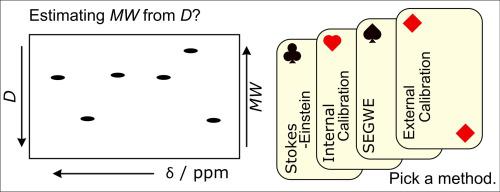当前位置:
X-MOL 学术
›
Prog. Nucl. Magn. Reson. Spectrosc.
›
论文详情
Our official English website, www.x-mol.net, welcomes your
feedback! (Note: you will need to create a separate account there.)
The Interpretation of Small Molecule Diffusion Coefficients: Quantitative Use of Diffusion-Ordered NMR Spectroscopy
Progress in Nuclear Magnetic Resonance Spectroscopy ( IF 7.3 ) Pub Date : 2020-04-01 , DOI: 10.1016/j.pnmrs.2019.11.002 Robert Evans 1
Progress in Nuclear Magnetic Resonance Spectroscopy ( IF 7.3 ) Pub Date : 2020-04-01 , DOI: 10.1016/j.pnmrs.2019.11.002 Robert Evans 1
Affiliation

|
Measuring accurate molecular self-diffusion coefficients, D, by nuclear magnetic resonance (NMR) techniques has become routine as hardware, software and experimental methodologies have all improved. However, the quantitative interpretation of such data remains difficult, particularly for small molecules. This review article first provides a description of, and explanation for, the failure of the Stokes-Einstein equation to accurately predict small molecule diffusion coefficients, before moving on to three broadly complementary methods for their quantitative interpretation. Two are based on power laws, but differ in the nature of the reference molecules used. The third addresses the uncertainties in the Stokes-Einstein equation directly. For all three methods, a wide range of examples are used to show the range of chemistry to which diffusion NMR can be applied, and how best to implement the different methods to obtain quantitative information from the chemical systems studied.
中文翻译:

小分子扩散系数的解释:扩散有序核磁共振光谱的定量应用
随着硬件、软件和实验方法的改进,通过核磁共振 (NMR) 技术测量准确的分子自扩散系数 D 已成为常规。然而,这些数据的定量解释仍然很困难,特别是对于小分子。这篇评论文章首先描述和解释了斯托克斯 - 爱因斯坦方程无法准确预测小分子扩散系数,然后转向三种广泛互补的方法进行定量解释。两种基于幂律,但所用参考分子的性质不同。第三个直接解决斯托克斯-爱因斯坦方程中的不确定性。对于这三种方法,
更新日期:2020-04-01
中文翻译:

小分子扩散系数的解释:扩散有序核磁共振光谱的定量应用
随着硬件、软件和实验方法的改进,通过核磁共振 (NMR) 技术测量准确的分子自扩散系数 D 已成为常规。然而,这些数据的定量解释仍然很困难,特别是对于小分子。这篇评论文章首先描述和解释了斯托克斯 - 爱因斯坦方程无法准确预测小分子扩散系数,然后转向三种广泛互补的方法进行定量解释。两种基于幂律,但所用参考分子的性质不同。第三个直接解决斯托克斯-爱因斯坦方程中的不确定性。对于这三种方法,









































 京公网安备 11010802027423号
京公网安备 11010802027423号